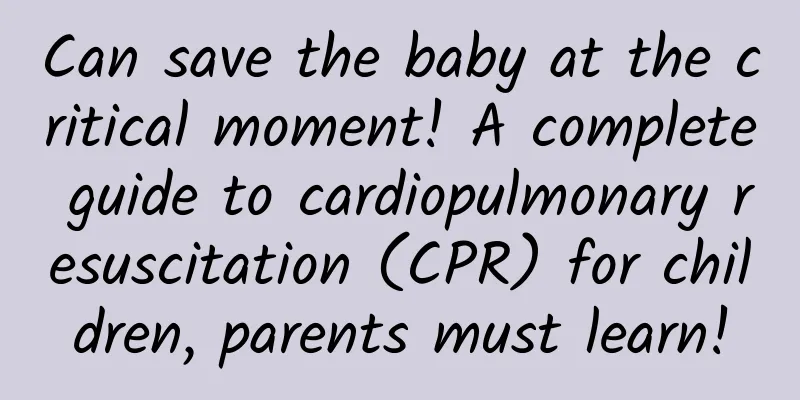Can save the baby at the critical moment! A complete guide to cardiopulmonary resuscitation (CPR) for children, parents must learn!

|
A friend who knows medicine around you / makes health easier As a parent or caregiver, your child's safety always comes first. However, accidents often happen unexpectedly - your child may suddenly suffocate, drown, or suffer a sudden cardiac arrest. In these critical moments, mastering pediatric cardiopulmonary resuscitation (CPR) skills may be the key to saving a child's life. Unlike adults, children's bodies are more fragile and require more precise strength and skills when operating. Today, we will explain the standard process of pediatric cardiopulmonary resuscitation in detail for you, so that you will not panic in an emergency and become the most solid "life guardian" of your child! Learning these can save lives at critical moments! Step 1: Quick Assessment and Call for Help 1. Determine the reaction: Pat the child on the shoulder and call loudly (such as "Baby, wake up!"). If there is no reaction, take immediate action. 2. Start the emergency system: •Single-person rescue: Perform CPR for 2 minutes (about 5 cycles) and then call 120 and get an AED. •Multi-person rescue: Immediately ask others to call 120 and find an AED , and start CPR at the same time. (Note: If the child suffers cardiac arrest due to suffocation/drowning, CPR should be given priority immediately) Step 2: Check breathing and pulse 1. Observe the rise and fall of the chest and abdomen: use 5-10 seconds to determine breathing (panting, sighing-like breathing or no breathing are considered abnormal). Note: When judging breathing, be sure to observe the rise and fall of the patient's chest. You can also judge breathing by observing whether there is airflow from the patient's mouth and nose or whether fog is generated on a smooth surface (such as a mirror). 2. Feel the pulse: Non-professionals can skip this step and directly determine the need for CPR by the absence of breathing; medical staff need to check whether the brachial artery (infants) or carotid artery (children) disappears (≤10 seconds). Step 3: Chest Compressions (CAB Sequence) 1. Pressing position: lower half of the sternum (below the midpoint of the line connecting the two nipples). 2. Pressing technique: • One or two hands : Small children can use one hand (base of palm), and older children can use both hands (same as adults). • Depth : 1/3 of the anteroposterior diameter of the thorax (approximately 5 cm). •Frequency: 100-120 times/minute . 3. Pressing requirements: • Ensure full chest recoil to minimize interruptions in compressions . •The ratio of compression to artificial respiration: 30:2 for one person rescue and 15:2 for two people rescue. Step 4: Open the airway and perform artificial respiration 1. Open the airway: tilt the head back and lift the chin (avoid leaning back too far as children’s necks are more fragile). 2. Artificial respiration: •Pinch the nose, cover the mouth (infants should cover both the mouth and nose) and blow slowly for 1 second. •The amount of air blown each time: based on the chest lift (about 300-500ml , avoid hyperventilation). • Take 2 consecutive breaths, each for 1 second . Step 5: Continuous Cycle and AED Use 1. Cycle operation: Compressions and breathing are alternated in proportion until the child resumes breathing/pulse, an AED arrives, or emergency personnel take over. 2. AED use: •Use the children's mode first (with children's electrodes), if not available, use the adult mode. •Electrode placement: One electrode is placed on the upper right chest, and the other electrode is placed under the left armpit (avoiding the sternum). Key Differences (Compared to Adults) Precautions Special treatment for infants (<1 year old) : •Compressions are performed using two fingers (for one-person CPR) or the circling thumb technique (for two-person CPR). •Cover mouth and nose with artificial respiration and blow smaller volumes of air (to avoid lung damage). Mistakes to avoid: • Pressing too deeply may cause rib fractures or organ damage. • Artificial respiration that is too fast or too much can cause gastric bloating. Post-resuscitation treatment: After resuscitation, place the patient in the resuscitation position (side-lying) and continue monitoring until sent to a hospital. Mnemonic shorthand • Rapid assessment → gentle compression → soft breathing → continuous circulation • "Press shallowly and blow slowly, children are more fragile, so the movements must be precise" Important note: Children have a special physiological structure, so operations need to be more cautious. It is recommended to master the details through professional training (such as the AHA Pediatric First Aid Course)! References: 1. Tencent Medical Encyclopedia 2. All network resources 3. Image source: Toutiao Author: Nurse Wang. A friend who understands medicine makes health easier. 1: The original articles published by Nurse Wang on this platform are protected as original works. Reprinting of original works is allowed. When reprinting, please be sure to indicate the article, original source, and author information in the form of a hyperlink. Otherwise, infringement will be investigated. 2: Nurse Wang respects the original works of other authors and reprints articles with the source. If there are any articles/videos/pictures involving the interests of third parties, please contact Nurse Wang and Nurse Wang will delete them in time. |
<<: Ice cream headache | Beware of the "ice cream assassin"
>>: Stop eating like a glutton! These types of people should pay special attention →
Recommend
This is what a young woman turned into after dieting to lose weight, scaring countless women to tears!
Now everyone knows that a light diet is good for ...
Why is Amaranth red when it is fried? How to eat Amaranth
Amaranth is an annual herb native to my country. ...
What is the blood sugar level during pregnancy?
Many situations of pregnant women are different f...
What should women do if they have vaginal bleeding during sexual intercourse?
I believe that many people now have vaginal bleed...
Reasons for cold belly during pregnancy
It's normal to have a cold belly during pregn...
Best time to get pregnant after laparoscopy
Laparoscopic surgery is a very common minimally i...
What are the dangers of lack of sleep for women?
Lack of sleep can cause great harm to women's...
Can I have sex on the first day after my period ends?
Many young couples always like to play exciting g...
Gallstones and benign gallbladder polyps: Things you need to know about gallbladder
When it comes to gallstones and benign gallbladde...
"Old leg ulcers", how much trouble do you have? Take care of your legs and worry less! - Let us help you understand venous leg ulcers
Author: Guo Minghua, Wang Lei, Wang Huan, Peking ...
When is the time for pre-pregnancy check-up? What should I pay attention to?
As a female friend who is about to become a mothe...
Which department should I go to for female urinary tract infection
Urinary tract infection in women may cause sympto...
What causes acne in girls
I believe that girls hate having pimples on their...
Bloody vaginal discharge after menstruation
Most female friends pay close attention to the co...
Correct treatment methods for women's endocrine disorders
It is very common for women to suffer from endocr...









